
IRF
IRF Uppsala
RPF programme
IRF-U Staff
Seminars
Courses
PhD studies
Examensarbete
Workshops
Cluster
...EFW
...Quicklook
Cassini
Rosetta
Solar Orbiter
Intranet
| INSTITUTET FÖR RYMDFYSIK | UPPSALA |
 |
|
| Swedish Institute of Space Physics | (59°50.272′N, 17°38.786′E) |
Project work (30 c)/Examensarbete (30 hp)
Quasi-parallel bow shock
Student: Andreas Johlander, Uppsala UniversitySupervisor: Andris Vaivads
Period: Spring 2014
Final report
Goal
How is energetic ion seed population formed at quasi-parallel shock?Abstract
Collisionless shocks in space plasmas are known to be capable of accelerating particles to very high energies. Particles are accelerated through a process called Fermi acceleration. However, this process can only act on particles with higher than thermal (suprathermal) energies. This population of suprathermal ions are called the ion seed population. The process of how the ion seed population is formed is still not fully understood. Our Sun emits charged particles in all directions, this is called the solar wind. Close to Earth, there is a region where the solar wind particles are slowed from supersonic to subsonic speeds, this region is called the bow shock. The region of the bow shock that we have studied is called the quasi-parallel bow shock. It is a region where the magnetic field forms a small angle to the shock normal. The quasi-parallel shock is a highly turbulent and dynamic region. One type of magnetic structures found here are short large amplitude magnetic structures (SLAMS), which are sharp planar waves. In this work, we study the formation of the ion seed population as a result solar wind ions being reflected off SLAMS in the quasi-parallel bow shock. For our analysis, we use data from the four Cluster satellites, which are in orbit around Earth. In particular, three instruments are used, one electric field instrument, one magnetic field instrument and one ion instrument. In this report we present observational data of ion reflection off a SLAMS. We perform simulations of an event to study the process of reflection. The simulations are shown to be highly consistent with observations. We then show how reflected particles can gain energy through interaction with the solar wind and form the suprathermal ion seed population. This ions ion seed population is also observed by Cluster.
![[A nice picture]](KraussVarban_quasiparallel_shock.png)
Earth magnetosphere as seen in numerical simulation. Courtesy: Dietmar Krauss-Varban.